|
|||
|
|
|
||
|
|||
|
|
|
||
|
|
|
|
|
History The convent and church of Sant’Alvise was built in 1388 at the behest of doge’s daughter Antonia Venier. Saint Louis, Bishop of Toulouse (Alvise is the transformation, via Luigi, of Louis into Venetian dialect) had appeared to her in a dream and told her to build a church in his honour, and where to build it. She later withdrew to the convent herself, with a group of fellow followers of the teachings of Saint Augustine, all women from noble Venetian families. The original wooden structures were rebuilt in 1430, due in no small part to the generosity of Pope Martin V, and this rebuilding was restored at the end of the 17th century. In 1807 nuns from nearbySanta Caterina moved here. Following suppression in 1810 the convent became a home for abandoned girls and the church became a parish church. Nuns returned later in the 19th century, transferring this time from Santa Lucia. The church The exterior is in a plain and lofty flat Gothic style. The 15th-century statue of Saint Louis over the main door is by the Florentine Agostino di Duccio. Interior The barco (nuns’ choir) at the back of the church dates from the 15th century, although its wrought-iron grill is an 18th-century addition. The nuns entered this raised gallery from the convent next door and remained unseen behind the grill for the service. A similar grill low in the right-hand wall allowed them to come down and take the sacrament. The decoration of the rest of the single-nave church dates from the 17th century - most overwhelming, and a bit incongruous, are the vertiginous trompe l'oeil ceiling frescos by Antonio Torri and Pietro Ricchi. Ruskin hated these works, blaming Veronese and his superior ceilings for inspiring such later and lesser artists. Art highlights Worth the trek out here are the triptych of panels by Giovanni Battista Tiepolo depicting Christ’s passion from 1740, commissioned by Alvise Cornaro, to whose name saint the church is dedicated. The two smaller side panels are fine (The Flagellation and The Crowning With Thorns, on the right wall of the nave at the east end) but the dramatic Way to Calvary (see below) on the right wall of the presbytery is better and looks like it might have been inspired by Tintoretto, who is not himself represented here, oddly, given his ubiquity in most nearby churches. The church acquired three important relics of Christ's suffering in 1456, the Chorus laminated guide sheet tells us, and thereby acquired a relic-related reputation, hence the theme of these Tiepolos.
Of The Way to
Calvary Bergeret de Grancourt (see above), an artist who
travelled to Italy with Fragonard in 1773/4, said it 'could not be
better composed, better organised; the expression is exact throughout...'
And Zanotto, a century later, compared this painting to a Raphael of the
same subject said that to appreciate Tiepolo the 'great composer. learned
draughtsman, magical colourist, wise historian and profound judge of the
passions' one must go to Sant'Alvise. |
|
|
|
History  The original church and monastery here was founded in the 11th century by the order of The Friars of the Penitence of Jesus Christ, who were also called the Sacchini friars because of their sackcloth robes. Following the suppression of the order in 1274 the complex passed to Augustinian nuns around 1289. Rebuilt in the mid-15th century, the church and monastery were suppressed by Napoleon in 1807, becoming a school, the nuns moving to Sant’Alvise. The complex served as a military hospital in 1915 and later became the Collegio Marco Foscarini. The church was damaged during World War I, and by a large fire on Christmas Day in 1977 which destroyed the roof, which was rebuilt. Interior Two aisles, with a ship's-keel roof and a large nuns' gallery. The church fittings are in a very poor state. Two side altars remain, one on each side, and the high altar in its charred-looking apse. No art remains. There are bits of painted wood partitioning and modern doors to further make for a functional but unlovely space. Lost art The lovely medieval English alabaster Saint Catherine Triptych (see below) with its original woodwork, was moved to the Ca d'Oro from this church after suppression. Sansovino had seen it on the altar of the Archangel Raphael in the right nave, which was funded and endowed by Zuan Antonio Nasi, in 1581, being used as a predella. As this sighting dates to a century after the triptych was made, and its subject doesn't fit the altar, it's most likely to have originally been placed on an altar owned by the local scuola dedicated to Saint Catherine. 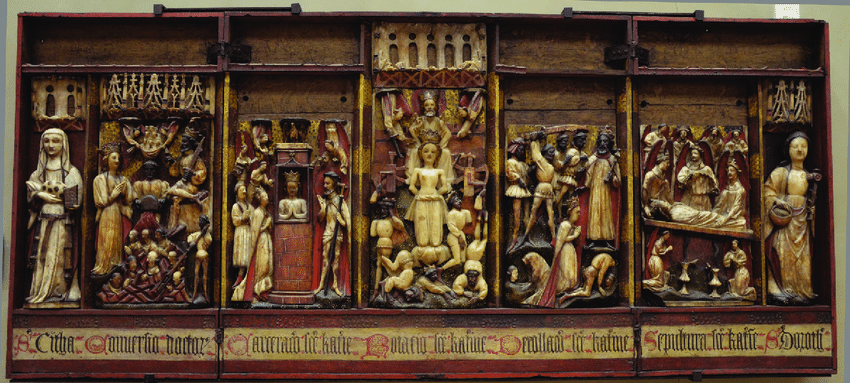 The slightly flirty blushing Madonna del Parto (see right) by the Master of the Madonna del Parto, from the late 14th century, is in the Accademia, in the chapel-like space to the left of the apse in the room converted from the Carita church. Also in the Accademia is Titian's Tobias and the Angel thanks to it never having been returned here following its looting by Napoleon. It has the Bembo coat of arms behind the dog - the connection with Pietro Bembo, aside from his friendship with Titian, being that his nieces were educated here, admittedly much later. This painting, which is a little flat-looking, has been attributed to 'a follower of Titian', possibly Sante Zago, but recently mostly to Titian himself. 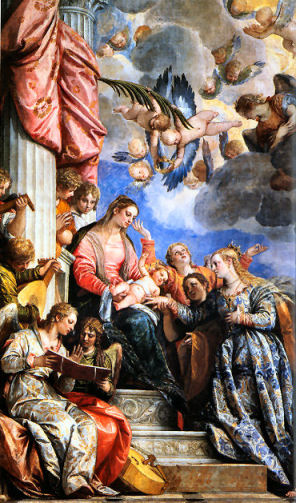 In the Accademia
too is Veronese's lush and glowing 1575 Mystic Marriage of Saint
Catherine (see right)
which was painted for the high altar (see far right) and taken
from here during WW1, reaching the Accademia in 1925. In the Accademia
too is Veronese's lush and glowing 1575 Mystic Marriage of Saint
Catherine (see right)
which was painted for the high altar (see far right) and taken
from here during WW1, reaching the Accademia in 1925.There was also a series of six paintings of Episodes in the Life of Saint Catherine, which hung along the sides of the choir, by Tintoretto and his studio, which were still here in 1904 but are now in the Patriarchal Palace. The are said to be mostly poor studio works, mostly the work of Domenico. From the mid-17th century, two Scenes from the Life of Saint Catherine (Saint Catherine refusing to worship idols and a Mystic Marriage) - oval panels painted for the ceiling of the left aisle of this church by Sebastiano Mazzoni, along with his swirling altarpiece of The Annunciation, with the Angel swooping in from top right, are in the Accademia, looking fine in the new rooms on the ground floor opened in 2021. From the same century, a Virgin and Child with Saints Augustine and Jerome by Pietro Ricchi (il Lucchese) is in the Sant’Apollonia Diocesan Museum. The monastery on TV The cloister features in Doctored Evidence, Episode 9 of the German TV adaptation of Donna Leon's Brunetti novels. Opening times The complex now belongs to a school. The church formerly housed portakabin schoolrooms but has recently been emptied and has been used for Biennale exhibits. Vaporetto Fondamente Nuove map
|
|
|
|
History The local popularity of Santa Fosca grew following the arrival of her body on the island of Torcello in the 10th century and the building of a church called Santa Fosca there in the 11th. This church is said to have been founded in 873, but was first documented in 1135, with renovation mentioned in 1150. More renovation followed in 1297 and a complete rebuilding in 1679, architect unknown. Reconsecration in 1733 was followed by the renovation of the façade by the Doná family, to a design possibly by Domenico Rossi. A plaque in the church commemorates the ceiling falling in after mass on the 24th of June 1761, but no one was injured. More restoration work followed in 1847. The artist Bernardo Strozzi is buried here. In 1542 the priest in charge, called Father Agostino, was found guilty of profanity and gambling and was banished and then hung in a cheba, a cage hanging from the campanile of San Marco.
The
church
Campanile 31m (101ft) manual bells
Vaporetto
San Marcuola |
|
|
|
History A hospice for repentant fallen women previously at Santa Marina in Castello transferred here in 1705, occupying buildings paid for initially by Maria Elisabetta Rossi and later by Marina da Lezze, noblewomen both, after the patriarch, later cardinal, Giovanni Badoer gained the approval of the Council of Ten. For admission to the Pio Loco delle Penitenti of San Giobbe the penitent women were required to be aged between 12 and 30, to be from Venice or to have lived there for at least a year, be mentally and physically sound, not pregnant and to have not indulged in the sinful life for at least three months. The complex here was designed by Giorgio Massari with the church opening in 1744 and consecrated in 1763. It was based on Palladio's Le Zitelle on Giudecca, with the church façade, which was never finished, flanked by blocks of accommodation. The complex is deep, with two cloisters, one behind the other. The complex, its original inhabitants numbers declining, after 1945 housed refugee women, mainly from Istria and the former colonies in Africa. It then become a residence for self-sufficient elderly women that closed in 1995. It has undergone extensive renovation work since 2009. This work completed, it now houses a care home for the elderly. Interior The Greek-cross plan makes for a tall and square space with white walls and pale grey stone detailing. On the side altars there is a Crucifix on the left and a painting of The Virgin in Glory on the right. The high altarpiece in the shallow apse shows The Virgin and Child with Saints Lorenzo Giustiniani, Margaret of Cortona, Mary Magdalene, Dominic, and Rose of Lima. by Jacopo Marieschi, the son of the vedute painter Michele. The ceiling of the apse has a small oval panel by the same painter of The Virgin in Glory with Saint Lorenzo Giustiniani. Lorenzo Giustiniani, the first patriarch of Venice, having been an early patron of the institution. Through the door at the back on the left is the worse-for-wear Cappella di Sant'Anna, with some old panelling, a crumbling altar, vestigial-blue-painted walls and a large hole in the floor.
Opposite The back end of the complex before the recent work.
Vaporetto
|
|
|
|
A photo from 1925. |
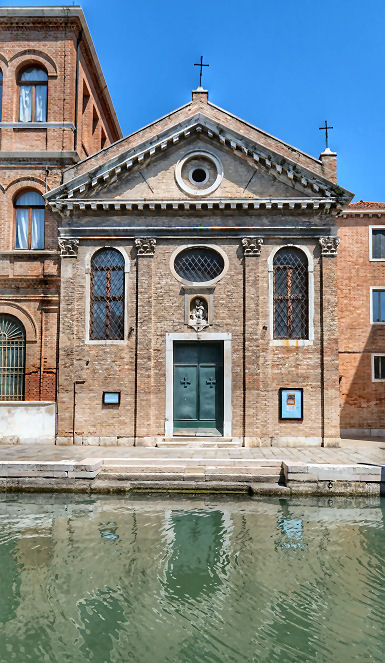
|
|
|
History A monastery of the Servite Order was founded here in 1316, with work on the church underway by 1330, which was not completed until 1474, with consecration following in the 7th of November1491. Reports state that this church was demolished in 1510 and rebuilt at the expense of the Servite friars. The church was conceived to compete with San Zanipolo and the Frari in size and status, as can be seen in the engraving (see right) by Domenico Lovisa after Luca Carlevarijs’s view of 1703. It consisted of an aisleless nave with two apsidal chapels either side of the presbytery, the Emo family chapel on the left and the Donà one on the right, and is said to have housed 23 altars. It covered almost eleven thousand square meters including, besides the church itself, the Cappella dei Lucchesi (also known as the Volto Santo) three dormitories and a refectory, as well as cloisters and orchards. Amongst the prestigious patrons in the late 15th and early 16th centuries were the heirs of Doge Andrea Vendramin and the ambassador and provveditore generale Giovanni Emo, demonstrated by their tomb monuments, and Girolamo Donà. There was a serious fire in 1769 which destroyed most of the monastery complex. The church and monastery were suppressed by Napoleon in 1812 and almost totally demolished. By 1821 nothing was left but the Cappella dei Lucchesi and two portals, including the 15th-century Gothic entrance (see prints far below and below right). The Cappella dei Lucchesi (see photo right), financed by silk merchants from Lucca, fleeing local political conflict in their home city, was built in 1360 at the edge of the site, while building was progressing, and was consecrated in 1376. Italian silk trade and manufacture had found a creative centre in Lucca and the Lucchesi merchants had used Venice as a port serving the east to import the silk, and later as a weaving centre itself. The Cappella still has its original ceiling, with images of the Fathers of the Church and the symbols of the four Evangelists, probably by Nicolò Semitecolo, just visible in the interior photo, right. The site was bought by Canon Daniele Canale who, along with Anna Maria Marovich, in 1864 founded a charitable institution for women just released from prison called the Istituto Canal Marovich ai Servi. The Cappella dei Lucchesi was rebuilt as the chapel for the institute, having been put to use as a warehouse. In the early 20th century the institute's scope broadened to include schooling for young girls of 6-11 years and 11-15 years. Generally these girls were orphans, which during and after WW2 also included girls who'd lost their fathers. The school closed in the late 1960s and the complex is now a student hostel. There have been rumours recently that the Cappella dei Lucchesi is due to be restored and opened for some sort of public use. Paolo Sarpi Frà Paolo Sarpi, a Servite monk since 1566, who later found fame as a theologian, scholar, anti-papal patriot and friend of Galileo, lived and studied here. His statue, by the Venetian sculptor Emilio Marsili, from 1892, is to be found in the campo in front of the nearby church of Santa Fosca. On the bridge near that church he was attacked by five papally-employed ruffians on October 5th 1607 as he returned to the Servi. They left him for dead but he recovered from his wounds, which included a dagger lodged in his ear. 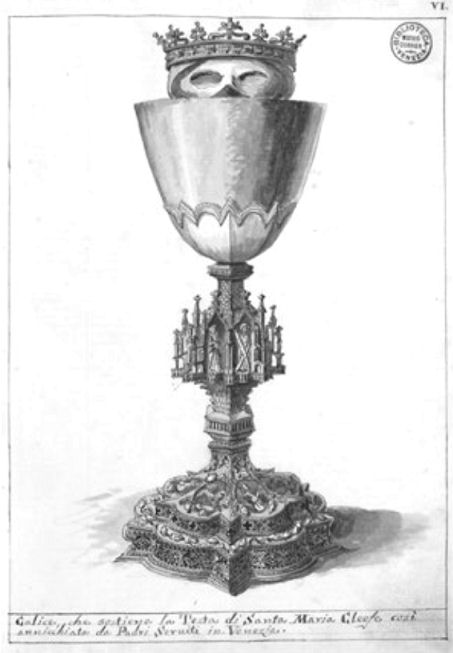 Renowned relics The importance of relics for the prestige and income of a church should not be underestimated, and this church had a lot which were, in 1533, collected on a marble Altar of the Relics (dedicated to the Holy Trinity) designed by Jacopo Sansovino, it is said. Amongst the most famous were the fragment of the titulus from the True Cross, the piece of wood with INRI written on it. The fragment is from the titulus one discovered in 1491 in the church of Santa Croce in Gerusalemme in Rome. It was given by Innocent VIII to Girolamo Donà, then the Venetian ambassador to the Pope, and given by Donà to this church when he returned to Venice in 1492. It is now in the Frari. Also famed and much-reported was the silver reliquary on the high altar here containing the head of Mary Cleophas (see right) one of the Three Marys, also known as 'the other Mary' or 'the mother of James'. Lost art A somewhat camp statue of Adam by Tullio Lombardo was carved around 1490 for the tomb of Doge Andrea Vendramin in the old church. The tomb was moved in 1819 to San Zanipolo initially. The statue of Adam, the Eve (not by Tullio) and two Shield Bearers were removed at this time because the patriarch at the time thought them indecent. Adam is now in The Metropolitan Museum of Art in New York. It suffered a catastrophic accident there in 2002 - The Fall of Adam - when it fell from it's pedestal and smashed into pieces. But it was been restored, taking somewhat longer than the two years initially promised - it went back on display in November 2015. More here. The Shield Bearers went to Berlin, where they suffered serious damage in the fires in the Friedrichshain flak tower (Flakturm) fires of May 1945. The church here also contained the tombs of Doge Francesco Donà (now at Meren near Conegliano) and Admiral Angelo Emo (now in San Biagio). A 14th-century relief of the Madonna della Misericordia, now over the door of the Scuola dei Calegheri e Zavatteri opposite the church of San Tomà, came from this church. The Deposition (see below right) by Giovanni Bellini and his studio (also attributed to Rocco Marconi, one of Bellini's pupils, after a design by Bellini made before his death) which is now in the Accademia was originally over one of the first altars on the right in Santa Maria dei Servi (the altar of the Barber's Guild, dedicated to Saint Martha, who is depicted to the left, behind Joseph of Arimathea) possibly installed after the 1510 rebuilding. San Filippo Benizi of the Servite Order is standing to the right, behind Mary Magdalene, and elsewhere you'll read that the figure on the left is in fact Saint Monica or Mary Cleophas. Reported in 1812 as being in poor condition, it was moved to the Accademia in 1829, undergoing intrusive restoration the following year. That work was reversed in a conservation in 1965, with the resultant swinging of the attribution back to Bellini himself. Also in the Accademia is Benedetto Diana's Virgin and Child with Saints John, Louis and Monica which was originally on the altar in the Sacristy here, as is a panel depicting Christ and His Apostles commissioned from Bonifacio de'Pitati for the relics altar here in 1533. Paolo Veronese's Feast in the House of Simon is now in the Château de Versailles, but was painted for the refectory here in 1570-73. Fra Damiano Grana, a prominent Servite who later became prior here, was Veronese's uncle. The work was sold to Louis XIV in 1664, to rescue the monastery from poverty and ease diplomatic difficulties between the Republic and France, following a brawl in Paris involving the Venetian ambassador and three grooms wearing the French king's livery. In 1730 it was installed in the Salon d'Hercule at Versailles. It was moved to the Louvre in 1832, but returned to Versailles in 1961. There was major restoration 1948, and two cleanings later, but it wasn't until the late 1990s that major work resulted in the revelatory removal of dingy varnish. An Assumption by Salviati from here replaced Titian's Assumption in the Frari during the 19th century, after Titian's painting had been moved to the Accademia for reasons of preservation and easier access. Salviati's painting had to have a two metre high panel added so as to fit in Titian's original's frame, painted by Antonio Florian with steps and column debris. It is now in the Rosary Chapel in San Zanipolo. The Correr Museum has two large worn wooden doors from here. The Ateneo Veneto, formerly the Scuola di San Girolamo, has in its entrance hall the tomb of Santorio Santorino (1636) a famous physician, taken from here. Formerly to be found in Girolamo Donà’s Altar of the Holy Cross, Andrea Riccio’s bronze tabernacle doors depicting The Exaltation of the Cross and four reliefs depicting the story of the True Cross are now in the Ca' D'Oro. Ruskin wrote Only two of its gates and some ruined walls are left, in one of the foulest districts of the city. It was one of the most interesting monuments of the early fourteenth century Gothic; and there is much beauty in the fragments yet remaining. How long they may stand I know not, the whole building having been offered me for sale, ground and all, or stone by stone, as I chose, by its present proprietor, when I was last in Venice. More real good might at present be effected by any wealthy person who would devote his resources to the preservation of such monuments wherever they exist, by freehold purchase of the entire ruin, and afterwards by taking proper charge of it, and forming a garden round it, than by any other mode of protecting or encouraging art. There is no school, no lecturer, like a ruin of the early ages. 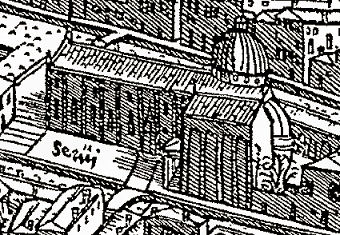 Opening times Opening timesThe Cappella dei Lucchesi: 9.00 to 12.15, 4.30 to 6.15 supposedly, but there's never been any evidence of any such opening. Although in 2017 correspondent Jane G reported attending a one-off concert there.
Vaporetto San Marcuola |
|
|
|
|
||
|
Santa Maria Maddalena
|
||
|
The church
Opening times |
|
|
|
Façade
The church in art
Local plans
|
|
|
|
History Tradition dates the founding of this church to 886, but the earliest written record is from 1111, with rebuilding reported in 1225, 1568 and 1698. The appearance of the current church mostly dates from 17th-century work by Antonio Gaspari. This church was burnt down on 28th February 1760, but was rebuilt. Suppressed in 1810, the church was sold to the Jewish community, but reopened and reconsecrated, following its purchase by Giovan Battista Rebellini, in 1836. The church
Lost art
Opening times
|
|
|
|
|
||
|
History This is supposedly one of the eight churches founded by San Magno (Saint Magnus) the Bishop of Oderzo in 643, built on a site where he saw twelve cranes, after an apparition of the Twelve Apostles told him to look for this sign. The church was rebuilt around 1020, with the first documented mention in 1094. It was destroyed by the fire of 1106 and rebuilt, and rebuilt again from 1570-75, probably by Alessandro Vittoria, with more work in the mid-18th century by Giovanni Pedolo. The church A plain façade (see right) with the more attractive side view dominated by the campanile and the domed exterior of the Cornaro Chapel (see below). 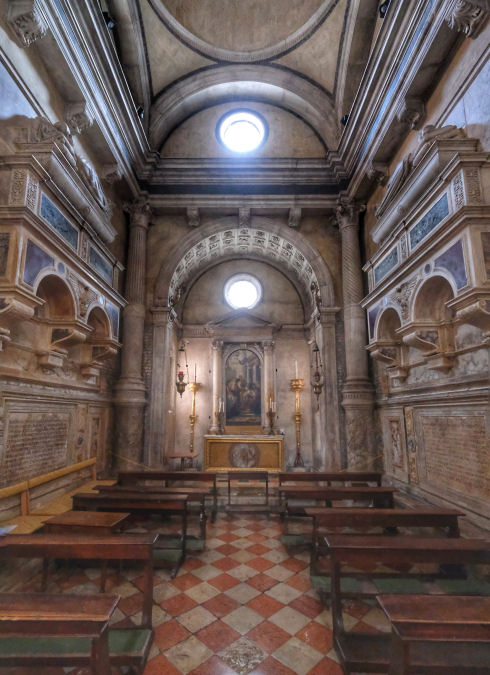 Interior InteriorA big dark box. Which all goes to throw into relief the lovely Cornaro chapel, the work of Giovanni Battista Castello. A bright and stony sanctuary (see left) it's all that's left of the pre-16th-century church and was built around 1490 (probably to a design by Codussi) for poor old Caterina Cornaro, Queen of Cyprus who was buried here in 1510. The chapel also has the tombs of her brother Giorgio (who died in 1540) and her father Marco (who died in 1511), the latter being attributed to Tullio Lombardo. Her body was moved to a big, flat and plain tomb in San Salvador around 1580. If I was her I'd have stayed here. The chapel also has a luminous late altarpiece by Giambattista Tiepolo of The Communion of Saint Lucy of c.1745/6, who had previously worked for the same family on the chapel just mentioned in San Salvador. A painting of the same subject by Benedetto Diana had been in the chapel here until at least 1740. The church has a sweet Veneto-Byzantine fresco fragment of c.1320 in the chapel to the right of the high altar, depicting The Deposition and The Interment. On the left wall of the nave there's a spooky little dark nun's balcony. The ceiling's architecture and decoration is the work of Antonio Dolabella, has paintings by Fabio Canal, dating to the mid-18th-century renovation, the main scene depicting The Last Supper. A Gathering of Manna by Paolo Veronese from 1580/5 is reported, but I missed it.  Campanile 47m (153 ft) electromechanical bells The 7th century campanile was destroyed by the fire of 1105. It was rebuilt in 1450, renovated 1601-09 by Francesco di Piero, brought down by a storm in 1659 and rebuilt 1672-1720 to a design by Andrea Tirali. Jan Morris says that an 'old and simple' sacristan fell from the campanile soon after its completion in 1672(?) but was caught by the minute hand on the clock, and so was slowly lowered to a parapet as time passed. Lost art The altarpiece by Benedetto Diana, commissioned by Giorgio Cornaro for the Cornaro chapel here, mentioned above, has since disappeared. As have the ceiling paintings which were also replaced during the 18th-century renovation. These were The Ascension by Aliense, the Descent of the Holy Spirit on to the Apostles by Montemezzano, and smaller scenes from the lives of the apostles by Dario Varottari. The church in art Canaletto's View of Campo Santi Apostoli (see right) Ruskin wrote The exterior is nothing. Opening times Monday to Saturday: 7.30 to 11.30 & 5.00 to 7.00 Vaporetto Ca d'Oro map |
|
|
|
|
||
|
History The Barefoot Carmelites (or Scalzi) a stricter offshoot of the Carmelite order, came to Venice in 1633 and in 1646 commissioned Baldassare Longhena (the architect of the Salute church at the other end of the Grand Canal) to design them a church and monastery, dedicated to Santa Maria di Nazareth. This (very) baroque church was built 1660-89, with finance provided by Girolamo Cavazza, and consecrated in 1705. Longhena directed building until 1673 when responsibility passed to the lay Carmelite Giuseppe Pozzo. The monastery was suppressed in 1810, but the order returned in 1840. The monastery buildings were demolished when the railway station was built. The church The façade was built 1672-80, by Giuseppe Sardi. It was also paid for by Conte Cavazza, who stumped up the necessary 74,000 ducats. The semi-clothed saints are attributed to Bernardo Falcone. It lays claim to being one of the better baroque façades in Venice - well ordered and proportioned and not too congested. Interior An unrelaxing baroque riot in polychrome marble, with walls and columns a colour reminiscent of salami, statues aplenty, and paintings on every surface. It has no aisles, but a sequence of three connected deep side chapels on each side of the nave, the middle ones much taller. Some welcome bright contrast is provided here by a couple of the chapels (the second on either side) having Tiepolo ceiling vaults - the early Saint Teresa in Glory on the right (c.1725 and one of his first frescoes) and The Agony in the Garden grisaille fresco on the left. The baldachin over the high altar is huge with Solomonic (barley-sugar) columns and statues of sibyls lounging about on the architecture - it's the work of the aforementioned Pozzo. Venice's last doge, Lodovico Manin, deposed by Napoleon in 1797, is buried here. Ruskin wrote 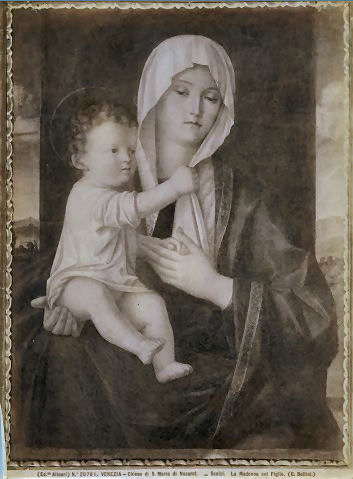 It possesses a fine John Bellini, and is renowned through Venice for its precious marbles. I omitted to notice before, in speaking of the buildings of the Grotesque Renaissance, that many of them are remarkable for a kind of dishonesty, even in the use of true marbles, resulting not from motives of economy, but from mere love of juggling and falsehood for their own sake. I hardly know which condition of mind is meanest, that which has pride in plaster made to look like marble, or that which takes delight in marble made to look like silk. Several of the later churches in Venice, more especially those of the Jesuiti of San Clemente, and this of the Scalzi, rest their chief claims to admiration on their having curtains and cushions cut out of rock. The most ridiculous example is in San Clemente, and the most curious and costly are in the Scalzi; which latter church is a perfect type of the vulgar abuse of marble in every possible way, by men who had no eye for colour, and no understanding of any merit in a work of art but that which arises from costliness of material, and such powers of imitation as are devoted in England to the manufacture of peaches and eggs out of Derbyshire spar.  Lost art Giambattista Tiepolo's ceiling fresco Miracle of the Holy House of Loreto from 1745 celebrated the house in Nazareth where Mary received the Annunciation, which angels brought to Yugoslavia when Saracens invaded in the 13th century, and then to Italy. The fresco was destroyed by an Austrian bomb, aimed at the nearby railway station, on the 24th of October 1915 (see before and after black and white photos below). It was part of Tiepolo's last fresco cycle for a church in Venice, executed with the help of Girolamo Mengozzi Colonna who took care of the illusionistic architecture. Seven fragments of the cycle are now in the Accademia, including the four illusionistic pendentive balconies, as is a preparatory sketch for this lost central panel. Are also photographs and a 20th-century copy. The 'John Bellini' mentioned by Ruskin above is no longer to be found here, but seems to have been a Virgin and Child which was also admired by George Eliot in her Journals. It was still here, behind the high altar, and described as 'the gem of the church', in the late 19th/early 20th century. Campanile 37m (120ft) electromechanical bells Built to a design by Longhena, it is topped by a small onion dome on an eight-sided drum. The garden and vineyard A huge garden behind the church which had fallen into ruin was restored in 2014 based on Spanish Carmelite nun Saint Teresa of Ávila's theory of the seven stages on the journey towards God. Saint Teresa is portrayed in the church on the ceiling by Tiepolo and in marble over an altar in the Cappella Ruzzini by Heinrich Meyring (1697) (see photo far right). The vineyards here have, like at San Francesco della Vigna, recently been put to wine production again. In 2010 the Venice Wine Consortium restarted the cultivation of 17 indigenous varieties of grape. A red wine, called Prandium, and Ad Mensam, a white are produced - around 900 bottles a year, available from here. Opening times Monday to Saturday: 7.45 to 12.30, 4.00 to 7.00 Sundays: 7.00 to 11.45, 4.00 to 6.45 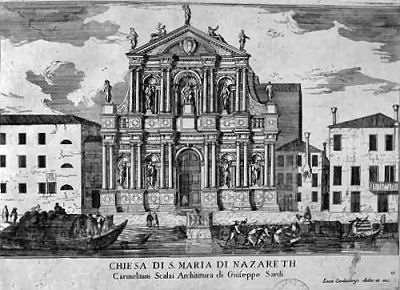 Vaporetto Ferrovia map |
|
|
|
|
||
|
History Begun in 1713 by Andrea Tirali, who is also responsible for the tambour on the top of the campanile of the Santi Apostoli church opposite, this church was built for the confraternity dedicated to the Angelo Custode (Guardian Angel). When the confraternities were suppressed in 1812 the building was bought by a German merchant called Sebastian Heinzelmann. German Protestants (moved from the Fondaco de Tedeschi, where they'd been since 1657) began using this building for worship, bringing with them two  paintings. One of these was
the Virgin in Glory with the Archangel Michael by Sebastiano
Ricci (see right). The Archangel Raphael with Tobias
sculpted group over the entrance is by Flemish sculptor Heinrich Meyring,
more (in)famous for his work on San Moisè. The building is now an
Evangelical Lutheran church. paintings. One of these was
the Virgin in Glory with the Archangel Michael by Sebastiano
Ricci (see right). The Archangel Raphael with Tobias
sculpted group over the entrance is by Flemish sculptor Heinrich Meyring,
more (in)famous for his work on San Moisè. The building is now an
Evangelical Lutheran church. Interior After passing through the more interesting and characterful entrance hall (see below) the church upstairs turns out to be a pale-walled bare and squareish space (see below right) with wood fittings and a few fine paintings. Foremost of these is the aforementioned high altarpiece by Sebastiano Ricci of The Virgin in Glory with the Archangel Michael, in which Michael is rescuing a child from the clutches of a sea monster. It contrasts with the portrait of Luther to its right, by the studio of Lucas Cranach (father or son, they're not sure). There's also a Titian painting of Christ on the left wall, given to the church when it was in the Fondaco de Tedeschi. Opening times (November 2021) Monday 10. 00 – 1.00, Friday 4.00 – 7.00 Vaporetto 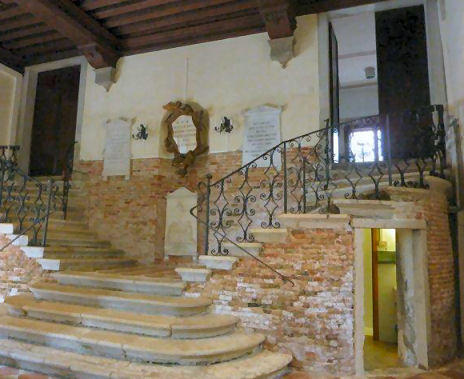 Ca d'Oro map
|
|
|
|
|